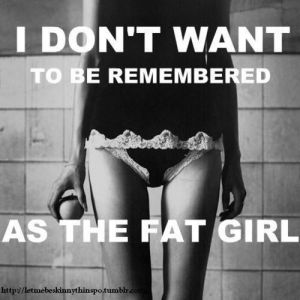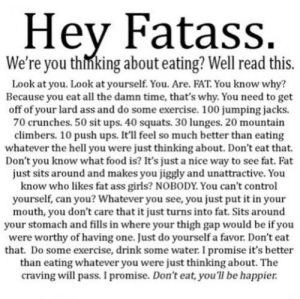Websites, blogs and images that are pro ana or pro mia promote anorexia or bulimia (ana and mia) by providing young people with “thinspiration” or “thinspo” (inspiration in the form of photos of skinny women or desirable bodies) and tips on how to lose weight by sticking to the “rules” of anorexia or bulimia. The eating disorders are often personified as Ana and Mia, imaginary friends there to help you on your way to perfection. Some “pro” communities are there to offer support and a forum for discussion on eating disorders for those who suffer from them, while other communities insist that ana and mia are lifestyle choices, and offer tips to “succeed”, such as crash diets like the ABC Diet (ana boot camp), posting caloric intakes daily as part of a contest to see who can eat the least, tips on how to reduce hunger pangs, and ways to hide the disorder from friends and family.
The promotion of eating disorders is littered with pithy sayings, as well. Phrases such as “A second on the lips, a lifetime on the hips” and “nothing tastes as good as skinny feels” (which can be attributed to Kate Moss in a 2009 interview), become mantras in the community, emblazoned across thinspo photos.
It’s well-documented in the scientific community that although the pro-ana and pro-mia community is a support network by nature, the support offered is often detrimental to recovery or living without an eating disorder. People encounter promotion of eating disorders either by looking to lose weight healthily, and then stumbling across it, or by looking for those suffering with similar issues.
Pro-ana and pro-mia media make it extremely difficult to escape the confines of an eating disorder if you are already living with one, and can easily snare those with vulnerabilities and insecurities. If you search the pro ana tag on tumblr, you are inundated with black and white pictures of painfully thin young women, poems, text posts admonishing eating over calorie limits, caloric intakes, and post upon post about thigh gaps and collarbones.
Because eating disorders are such isolating conditions, those who live with them find a surrogate family in the form of pro ana or pro mia communities. Speaking from personal experience, I had friends I met on tumblr who I would text daily, discussing our hunger pangs and meticulously laying out plans for our weekly caloric intakes. Disordered behavior, from as innocuous seeming as only eating half your meal and then throwing the other half out to as obvious and damaged as deliberately purging after a meal, is normalized and accepted in the eating disorder promotion communities. Surrounded by a virtual community of those applauding your symptoms, it becomes nearly impossible to leave those offering you support.
Dr. John Morgan, chair of the Royal College of Psychiatrists’ Eating Disorders section has this to say on pro ana and pro mia websites:
In the coming days, I’ll be compiling interviews with people who have survived eating disorders and will be including their thoughts on pro ana, pro mia and thinspiration in general.
Up next: recovery communities in contrast with disordered communities


